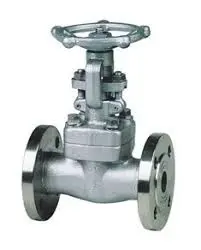The opening and closing part of
the high pressure gate valve is a wedge, and the motion direction of the wedge is perpendicular to that of the fluid.
Gate valves are used to shut off the flow of liquids rather than for flow regulation.
Characteristics of High Pressure Gate Valves
1. The valve is connected by the medium flange bolt, and both ends of the branch pipe are of flange connection.
2. The sealing surface of the valve seat is made from Fe-Cr-Ni stainless steels by surfacing so that the seat has good wear resistance and scratch resistance.

3. Nitrogen treatment, used for the surface of the valve stem, adds good corrosion resistance and scratch resistance to the stem.
4. The closing and opening of
the high pressure gate valve is controlled by the electric actuator installed on the bonnet. Electric actuators are equipped with special motors for valves, reduction boxes, torque control mechanisms, stroke control mechanisms, field operation mechanisms, and manual-electric switching mechanisms. The switch of the valve is adjusted by the stroke control mechanism, and the torque limiter mechanism is adjusted to protect the valve when the stroke control mechanism fails.
5. The electric actuator can be operated locally and remotely.
Structural Characteristics and Uses of High Pressure Gate Valves
1. The electric high-pressure gate valve has compact structure, reasonable design, good rigidity, smooth passage and low flow resistance.
2. The sealing surface of the high pressure power station gate valve is made from stainless steel and cemented carbide so that the valve has long service life.
3. The electric high pressure gate valve adopts flexible graphite packing and has reliable sealing and handy operation.
4. The driving means are divided into manual, electric, pneumatic and gear transmission.
5. As opening and closing devices for connecting or cutting off the medium in the pipe, high pressure power station gate valves are widely used in oil and steam pipes such as those in petrochemical and thermal power plants.
